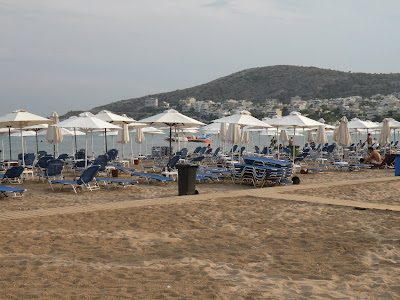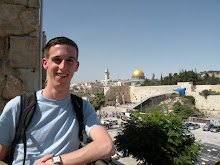So, I left off in Athens!

We took a two-day trip to the Corinth area. Here we find the Temple of Apollo, unique for its one-piece columns (as opposed to multiple pieces comprising one column). One of the biggest cities in the ancient Greco-Roman world, Corinth contained approximately 150,000 people within 10 km (about 6 miles) of city walls. For a first century city, that's huge!

The city is also famous for the Erastus inscription, which is an inscription near the theater that reads "Erastus laid the pavement at his own expense for return of aedile." The aedile was essentially the public works director. This inscription not only establishes Erastus as the aedile of Corinth, but it verifies 2 Timothy 4:20, which mentions Erastus. Erastus was unique because in a position appointed directly by Caesar, his power could have led to corruption. Instead of taking advantage of the city, he becomes one of Paul's helpers, and in the inscription, we learn that he was actually a benefactor of the city.

Acrocorinth is the acropolis of Corinth - basically, the fortress on a hill protecting Corinth. From here we're looking through an opening in the fortress and down onto the valley opposite of the city of Corinth.

We spent the night in Nafplion, a city on the SE coast of the Peloponnese (the large peninsula to the W of Athens). While sitting at a cafe in Nafplion, watching the sunset and having some wonderful Greek desserts, lots of bikers rode by.

The next morning, we went up to a fortress overlooking Nafplion and got this view of the city jutting out into the water. The city is actually on the other side, along with the harbor. This is the side where a couple of friends and I had gone the night before to listen to the waves on the rocky shore.

The theater of Epidaurus, one of the best acoustical sites in all of Ancient Greece. You could hear the striking of a match from the very top, 45 rows up! The theater seats about 15,000 people. It was incredible! As a group, we sang the doxology and let our praises ring, imagining ourselves in company of the ancients!

On Friday (June 25), we had a free morning. A friend and I went down to this fruit and vegetable market in Athens and walked around a little. We decided to buy a watermelon from this guy - watermelon is very popular in Greece!

Waiting for the metro ride back to where we stayed, Bethel, about an hour outside Athens center.

That afternoon, we got to visit the Athens Archaeological Museum - incredible, as you might expect! My favorite part was learning about the development of statues throughout Ancient Greece. In this picture, we see from the Archaic Period a kouros (male) figure that was huge - 2 meters (about 6.5 feet)! Notable elements of these statues include the left foot forward, large eyes, and a big mouth with a "sly smile" (though you can't see the mouth well in this picture!). As statues developed, their eyes became smaller, ears more natural, and hair shorter. Moving into the Classical Period, sculptors emphasized more muscle definition, and the art of balancing the statue in a more realistic, human-like was developed. The next two pictures are most likely from the Classical period.

Young jockey (on top of a horse, out of the picture ) - motion, passion, realism!

A bronze statue from the Classical period. If you look closely, you can see that eyes were made from a different material.

After the Archaeological Museum on Friday, we made our way down to Cape Sounio, on the Southern tip of the mainland. We got to partake of the "company of Poseidon" (swimming - Poseidon is the sea god) for a couple of hours, then watch the sunset from the hill above the beach.

On the hill above the beach is the Temple of Poseidon. Standing among these ancient ruins, I witnessed one of the most awe-inspiring sunsets of my life! The Temple of Poseidon is appropriately placed right on the sea. The Ancient Greeks weren't illogical! Not at all.




The next day (my birthday!) we went to the ancient oracle of Delphi, where Apollo was believed to reside and give advice to anyone who asked the oracle a question. Here we see theater of Delphi in the foreground and the doric columns of the Temple of Apollo in the middle ground. The spot was considered sacred by people worldwide, so many civilizations would bring their treasures to Delphi - no one would dare plunder a holy place, irregardless of whose treasure it was! So we're left with many treasuries at Delphi.
The oracle was the place where Apollo would speak, and a woman called the "pythea" would voice mumblings, which a priest would then interpret as an answer to a question that someone would ask. The site was considered the "navel" or the "center" of the earth. We also made the parallel (as crazy as it sounds!) between Apollo and Jesus Christ. The only son of the chief god, Zeus, Apollo fought with a snake and won and could not stand anything impure; he was a god of purification. In essence, this cult of Apollo showed the desire of the Ancient Greeks to find the truth and the true God. Even Constantine, the Roman emperor who made Christianity the official religion of the state and issued the Edict of Milan in the early 4th cent. AD, was a devotee to Apollo. In fact, we see that Christianity developed as a type of syncretism between "pure" Jewish monotheism and Greek mythology - a "Greek religion with a Jewish accent." And at Delphi, the priests would interpret the words of God - how much has changed? The basic questions are still the same: what's in my future? Our desire to know and have a connection with the divine persists through millenia. Is this a triumph? I think it's more of a testament to our innate longing for the Lord, for a Savior, for a Rescuer.

The beach on the southern coast of Greece (Varkiza) where we spent the day relaxing and enjoying the company of Poseidon! We ended the day with dinner on the beach - octopus and a seafood pasta!

Our group at Bethel right before leaving for our flight to Rome (on Tuesday June 29).
As a camp and retreat center, Bethel is an important hub of the evangelical presence in Greece. With a 95% Greek Orthodox population and very few evangelical Christians, it is encouraging to see such a strong ministry like Bethel. Our tour guide, Voula, and her husband, Socrates, head up Hellenic Scripture Union, which is housed at Bethel, as well. Bethel also contains a home for the elderly, which provides a place for many elderly people to live where they won't be the target of snide and degrading remarks (being Protestants), and where they can be treated with dignity. We can praise God for the ways He works through Voula, Socrates, and the people at Bethel. Seeing the joy on their faces and in their hearts was an encouragement to me and the rest of our group. In fact, one of our professors, who is from Greece, grew up going to Bethel! So it was certainly an important place to stay in our trip. And what a blessing it was to travel through Greece with a tour guide like Voula who is passionate about the Gospel and the historical significance of the land.

Hello, Philip! I am a student from the Philippines, and I am requesting to use one of your photos (the photo of the columns from Greece) for a poster project of mine that is for a campaign in school. I will credit you accordingly! Thank you, and I look forward to hearing back from you. I will check back again :) Cheers!
ReplyDelete